火星 月惑星研究会 関西支部

Mars Image 2005/11/07(UT)
米山誠一,三品利郎,風本明,新井 優,永長英夫,野々口猛浩,柚木健吉,瀧本郁夫,熊森照明,池村俊彦,林敏夫,岡本彬宏,安達 誠,田阪一郎
Carlos.E.Hernandez,Christopher Go,Elias Chasiotis,James Jefferson,David Arditti,Robert Heffner,Ralf Vandebergh,Lorenzo Comolli,Geert Vandenbulcke,Hubble Space Telescope
S.Yoneyama,T.Mishina,A.Kazemoto,M.Arai,H.Einaga,T.Nonoguchi,K.Yunoki,I.Takimoto,T.Kumamori,T.Ikemura,T.Hayashi,Y.Okamoto,M.Adachi,Carlos.E,Christopher Go,Elias,J.Jefferson,D.Arditti,R.Heffner,R.Vandebergh,L.Comolli,G.Vandenbulcke,HST,I.Tasaka
解説(安達)
明け方の朝霧が、偏りを持つようになった。米山氏と三品氏の画像では、そ
の様子が良く分かる。野々口氏も肉眼でその様子を確認している。SPCは今日
も黄色くなっている。また、アキダリウム(Mare Acidarium;30W+50)付近のダス
ティーな部分にも霧は見られない。これによると、ダスティ−な部分には霧が
出にくいように見える。
今回、柚木氏によってブルークリアリングが初めて記録された。画像は、450
nm以下のレンジであることから、確実な記録だ。これからどの位の期間見えて
いるかを記録に残したい。 (reported by 21 observers)
The morning mist at the dawn came to show bias. In the image of Yoneyama
and Mishina,the appearance is understood well. Nonoguchi also confirms
the appearance by the visual observation. SPC has yellowed today.
Moreover,the fog is not seen in dusty region in the vicinity of Mare
Acidarium (30W,+50). According to this,it is seems not to fog rises
easily in dusty region.
This time,blue clearing was recorded by Yunoki for the first time.
The image is from wavelength of 450nm or less to a reliable record. I
want to leave whether to have seen it for the period of the future of
which place for the record. (reported by 21 observers)
FROM Makoto ADACHI
-------------------------------------------------------------------------------------
|
Seiichi Yoneyama(200mm F4 Newton,ToUcam PRO)
|
雲が多く、雲間からどうにか1回だけ撮影できましたが、シーイングがかなり悪く、火星が多角形に見えていました。
朝霧が目立っていました。
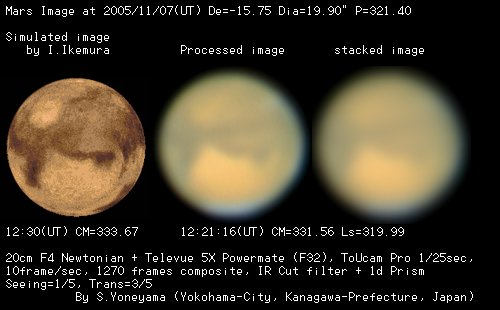 ≪神奈川県横浜市 米山誠一≫
≪神奈川県横浜市 米山誠一≫
|
Toshirou.Mishina (200mm Newtonian,ToUcam Pro)
|
UT 14:50 印象(眼視)
北極の雲が青く輝いていた。そして、朝霧が薄青く見えた。
UT 14:50 Impression (visual observation)
I saw the cloud of the North Pole shine bluish. And I saw the light blue clud at Mars' morning terminator.
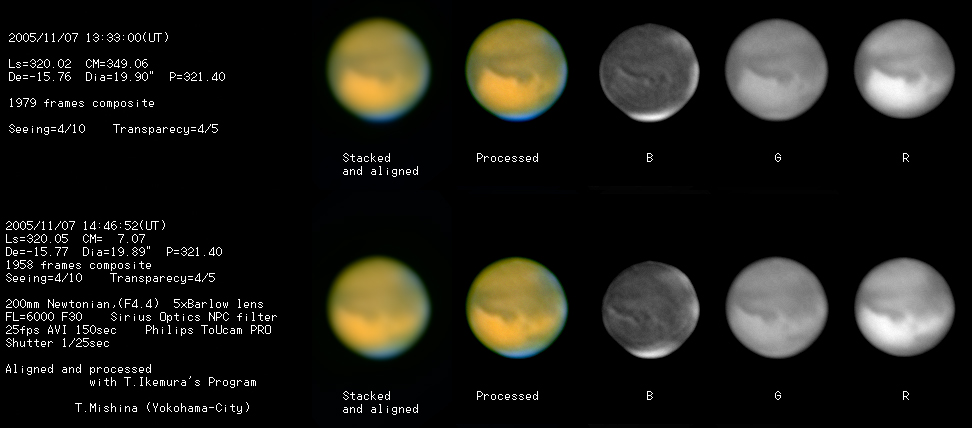 ≪神奈川県 横浜市 三品利郎≫
≪神奈川県 横浜市 三品利郎≫
|
Akira Kazemoto(308mm Newton,308mm Newton,ToUcam Pro)
|
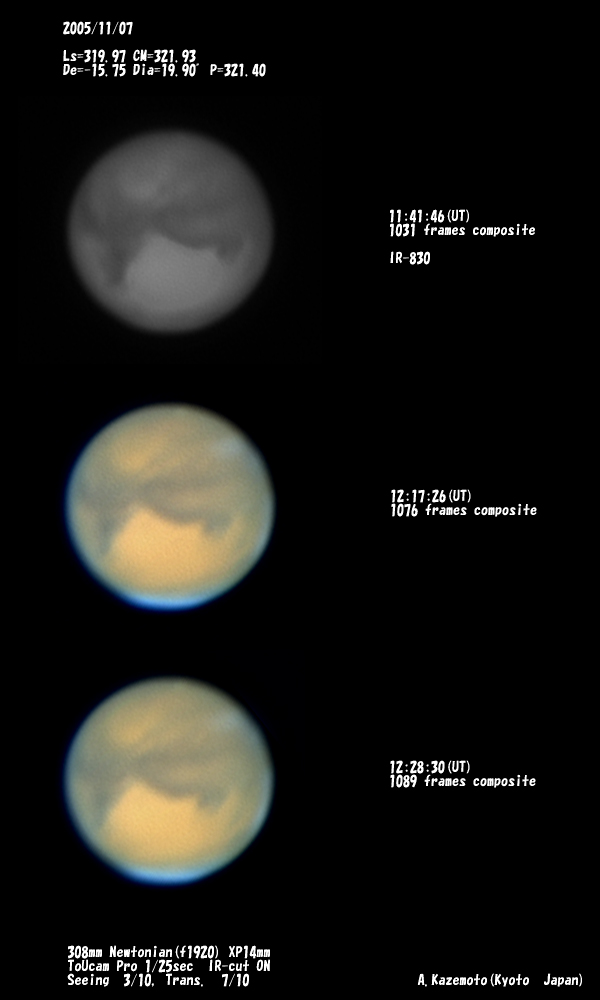 ≪京都府久世郡 風本明≫
≪京都府久世郡 風本明≫
|
Masaru Arai (280mmSMC Newton,Philips ToUcam Pro PCVC740K)
|
280mm SCT,2×Extender、 Philips ToUcam Pro,1/50 sec
1400/1500frames composite Seeing:1-2/10 Transp5/5
−−−−−−−−−−−−−−−−−−−−−−−−−−
気圧配置が冬型に変わり始めたようで、Seeingが悪い状態でした。
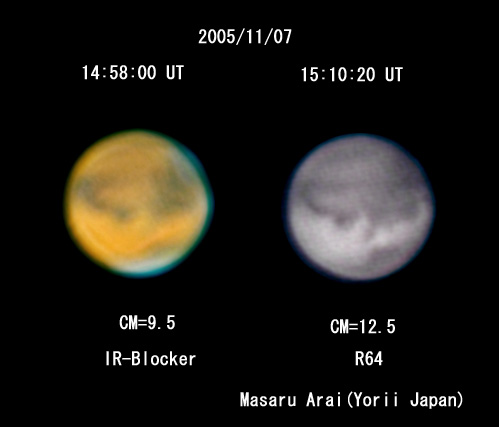 [Masaru Arai Yorii-machi Saitama-Prefecture Japan]
≪埼玉県寄居町 新井 優≫
[Masaru Arai Yorii-machi Saitama-Prefecture Japan]
≪埼玉県寄居町 新井 優≫
|
Hideo Einaga (250mm Newton,Toucam Pro Webcam)
|
 [Hideo Einaga Kasai-City Hyogo-Prefecture Japan]
≪兵庫県 加西 永長英夫≫
[Hideo Einaga Kasai-City Hyogo-Prefecture Japan]
≪兵庫県 加西 永長英夫≫
|
Takehiro Nonoguchi (Drawing: 105mm refractor)
|

[Takehiro-Nonoguchi Takamatu-Kagawa-Japan ]
≪野々口猛浩 香川県高松市≫
|
Kenkichi.Yunoki (200mm Newtonian,ToUcam Pro)
|
撮像時、モニター上のB1(370〜530nm)画像を見ると普段より模様がはっきりと見えたので、ブルークリアリングかと思い、450nm以下のB2フィルターに替えて撮像した。処理後の画像を見ると、普段は450nm以下のB2ではB1に比べ地表の模様はほとんど写らないが、この日はどちらもほぼ同じように模様が写っています。衝付近に起こるというブルークリアリングかも知れません。今期このように450nm以下のBで模様が写ったことは初めてです。11月03日にこの付近を450nm以下のBで撮っていますが、その時は模様は写っていません。
アルギュレからソリスにかけてとても明るい雲が出ています。
また、Red Storm(?)はデゥーカリオンからエリュトラエム、アウロラエ付近まで拡大しています。もっとも、この赤く見える現象は例会で安達氏より、砂などの実態のあるものではなく火星大気の散乱に基づくものではないかとの話がありましたが。

[Kenkichi Yunoki (Sakai City Japan)]
≪大阪府 堺市 柚木健吉≫
|
Ikuo Takimoto (310mm Newtonian :ToUcam Pro )
|
コメント:北極付近が青白く輝いています。
アルギュレ付近が明るくなっているのが解ります。
ヘラスの北部が二重になっているようです。
シーイングは良くありませんし、天頂近くになるほど
悪化しました。
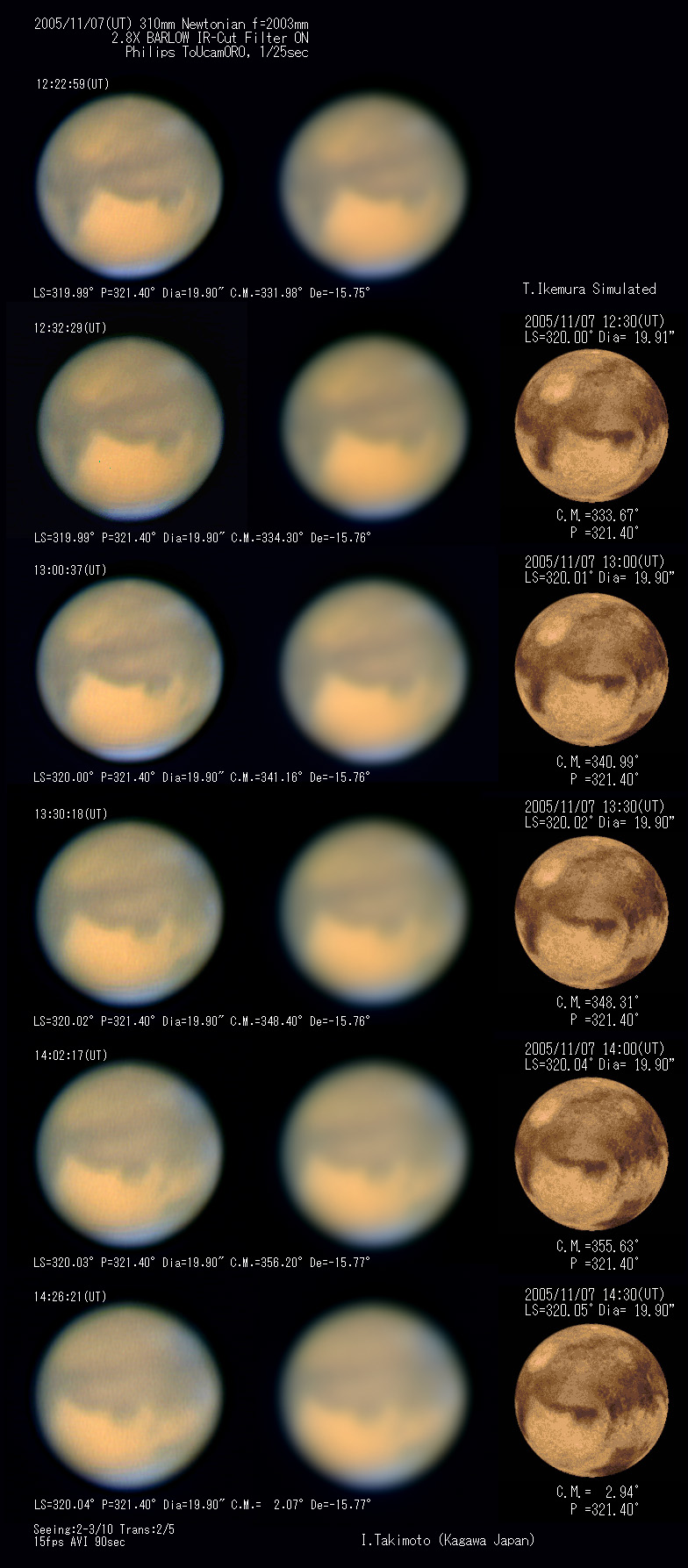 [Ayauta-gun Kagawa-Prefecture Japan]
≪香川県 綾歌郡 瀧本郁夫≫
[Ayauta-gun Kagawa-Prefecture Japan]
≪香川県 綾歌郡 瀧本郁夫≫
|
Teruaki Kumamori (200mm Dall-kirkham,PHILIPS ToUcam Pro)
|
黄雲はずいぶんと落ち着いて来たようです。
 ≪大阪府堺市 熊森照明≫
≪大阪府堺市 熊森照明≫
|
Toshihiko Ikemura (310mm Newton,ATK-2C 2HS)
|
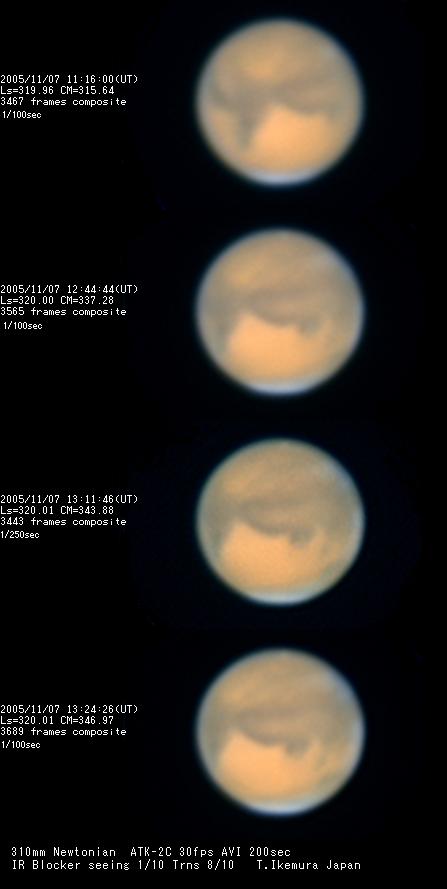
The seeing was terribly poor.
ものすごくシーイングが悪い。
[T.Ikemura Nagoya Aichi JAPAN]
≪愛知県名古屋市 池村俊彦≫
|
林敏夫 Toshio Hayashi (355mm Schumidt-Cassegrain,Philips ToUcam Pro )
|
シーングが悪い割りに、画像処理で日の出地域の朝霧が撮れた。
真珠の湾のダストが、収まって以前の模様が戻ってきたようだ。
 ≪京都府京都市 林敏夫≫
≪京都府京都市 林敏夫≫
|
Yoshihiro Okamoto (Drawing: 203mm SCT)
|
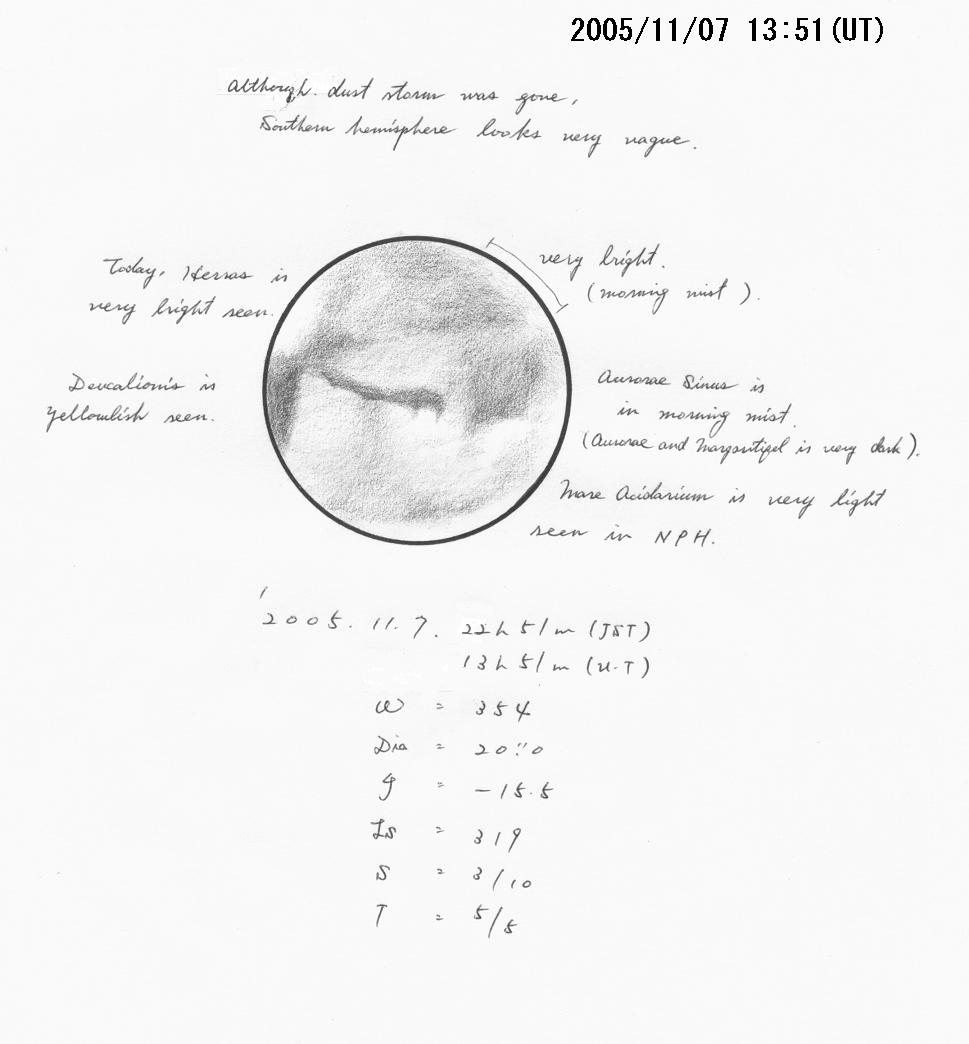
-----------------------------------------------------

-----------------------------------------------------
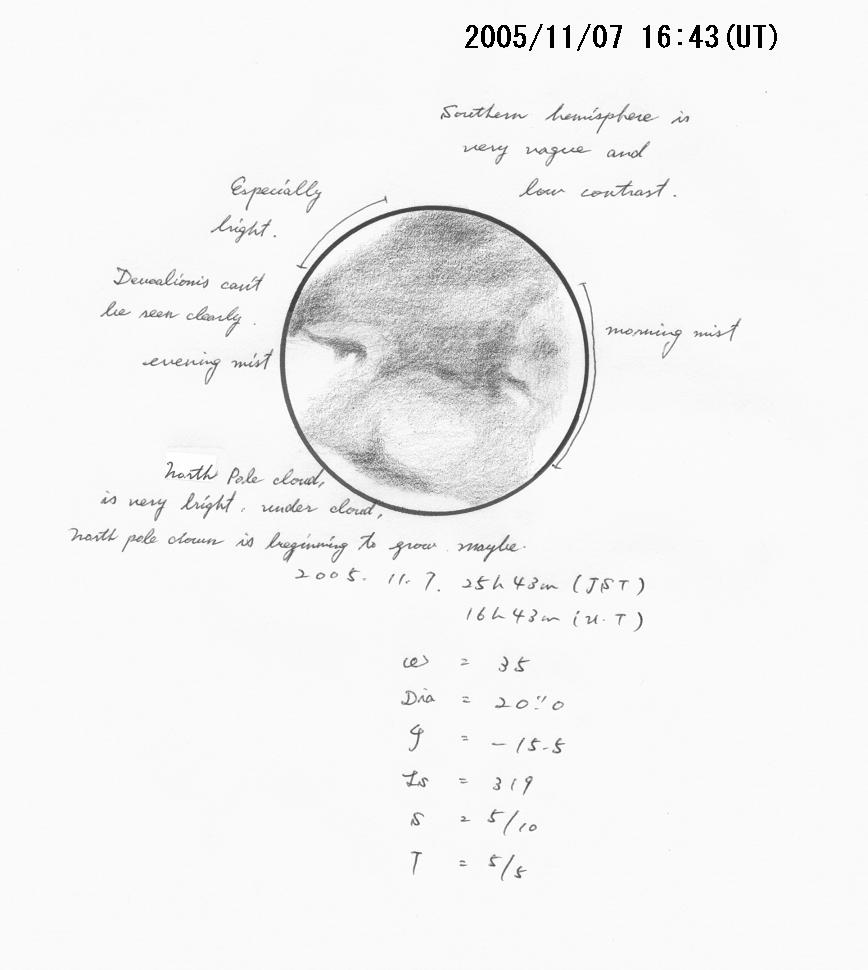
-----------------------------------------------------
[Minoo-shi Osaka-prefecture Japan]
≪大阪府箕面市 岡本彬宏≫
|
Makoto Adachi (Drawing: 310mm Newtonian)
|

--------------------------------------------------------------
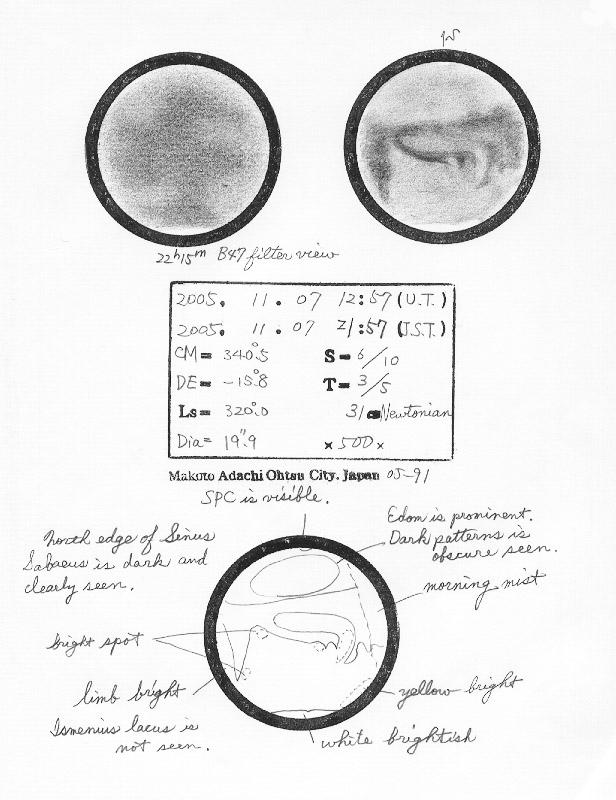
--------------------------------------------------------------

--------------------------------------------------------------
<Makoto Adochi Ohtu Shiga Japan>
≪滋賀県 大津市 安達 誠≫
|
Carlos E. Hernandez (Drawing:9-inch (23-cm) F/13.5 Maksutov- Cassegrain)
|
I made a pair of Mars observations on November 7,2005 (02:15 and 02:50 U.T.) under average seeing conditions (5/10,the atmosphere did steady for brief moments to 6-7/10). Electris and Eridania appeared bright and both exhibiting a mildly yellow-mustard color (dust?). "Valhalla" was diffusely visible following the CM. I welcome any comments that you may have on on my observations.
Date (U.T.): November 7,2005
Time (U.T.): 02:15 (left image) and 02:50 (right image)
CM: 183.7 (left image) and 192.2 (right image)
Ls: 319.8 (Mid-Northern Winter/Southern Summer)
De: -15.3,Ds: -15.7,p 1.00,19.94"
Instrument: 9" F/13.5 Maksutov-Cassegrain
Magnification: 248x and 388x
Filters (Wratten): 30 and 38A
Seeing (1-10): 5,Antoniadi (I-V): III
Transparency (1-6): 4
Notes:
02:15 U.T. Left image, CM 183.7, IL/W30): The South Polar Cap (SPC) appeared over the southern limb as a thin, brilliant (10/10) oval (not as readily visible from this longitude). Mare Australe and Mare Chronium appeared dark to dull (3-5/10) and mottled. Phaethontis appeared bright (7/10). Electris and Eridania wee also bright (7/10) but appeared to be mildly yellow-mustard tinged (dust?). Mare Sirenum appeared dark (3/10) and mottled. Mare Cimmerium appeared dark to dusky (3-4/10) and mottled as well. "Valhalla" appeared as a diffuse, dull (5/10) band north of Mare Cimmerium. Zephyria and Aeolis appeared bright to very bright (7-8/10) north of Mare Cimmerium as well (water vapor cloud vs. dust). Memnonia, Zephyria, Aeolis, Aethiopis, and Aetheria appeared bright (7/10). Elysium appeared shaded to bright (6-7/10) preceding the CM. Phlegra appeared dusky to dull (4-5/10). The Hyblaeus Extension appeared dark to dull (3-5/10) and mottled following Elysium. Utopia appeared dusky to dull (4-5/10) following the CM. An extremely bright (9/10) evening limb haze (ELH) and morning limb haze (MLH) were noted. An extremely bright (9/10) North Polar Limb (or Hood?) was noted as well.
02:50U.T. (Right image,CM 192.2,W38A): Mare Sirenum and Mare Cimmerium were dull (5/10) preceding and following the CM,respectively. Bright to very bright (7-8/10) clouds were noted over Phaethontis,Electris,Eridania,Zephyria,and Aeolis. Extremely bright (9/10) evening limb haze (ELH),morning limb haze (MLH),North polar limb,and South polar limb were noted.
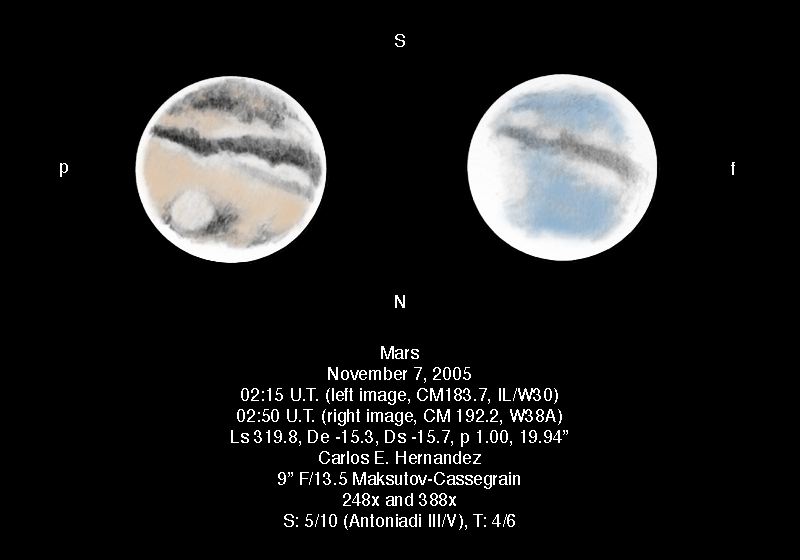
[[Carlos.E. Hernandez South Florida U.S.A ]]
|
Christopher Go (Celestron C11,DMK21BF04 monochrome camera)
|
Here's my best image of Mars! This covers the region around Sinus Sabaeus. Note the nice could details on the right limb of Mars.

[Christopher Go : Cebu Philippines]
|
Elias Chasiotis (127mm Makstov Cassgrain EXT125 : ATIK 1C )
|
 Mars fifteen hours after opposition. Note the bright central area of the disk that gives a three dimentional impression.
Also,the Olympus Mons are very prominent. Mars fifteen hours after opposition. Note the bright central area of the disk that gives a three dimentional impression.
Also,the Olympus Mons are very prominent.
[Elias Chasiotis,Markopoulo Greece]
《エリアス カシオティス ギリシャ アテネ》
|
James Jefferson (Meed ETX 125AT:ToUcam Pro2)
|
I managed (after a cloudy night) to sit down and process my earlier attempts at Mars taken at Midnight.
I don't know how much more I can pull out of the ETX,but im so very happy with this image.
This e-mail (and any attachments) is confidential and may contain
personal views which are not the views of the BBC unless specifically
stated.
If you have received it in error,please delete it from your system.
Do not use,copy or disclose the information in any way nor act in
reliance on it and notify the sender immediately. Please note that the
BBC monitors e-mails sent or received.
Further communication will signify your consent to this.
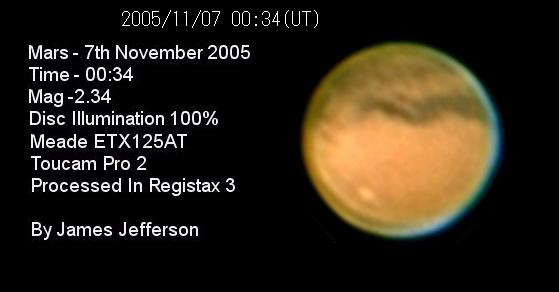 [James Jefferson: United Kingdom]
[James Jefferson: United Kingdom]
|
David Arditti (250mm Dall-Kirkham Cassegrain:ATK camera)
|
Here is a set from Nov 07,a night of fairly good seeing in London.
It is clear why the old telescopic name of Olympus Mons was Nix Olympica,the "Snows of Olympus". All observers have noted this extraordinary brightness. In adition to this cloud,apparent even in the raw videos,there are white clouds evident over the Tharsis volcanoes (retreating over the preceeding limb) and over Elysisum Mons (coming into view from the following limb in the N hemisphere).


[David Arditti: Edgware Middlesex HA8 5LW: United Kingdom]
|
Robert Heffner (280mm SCT : Lumenera LU075)
|
I send you a Mars image from 2005/11/07 14:57 UT
Comments: Very,very poor image taken in the jet stream. Strong pattern of
the jet continues to rage overhead of Japan:
ftp://virga.sfsu.edu/pub/jetstream/jetstream_norhem/0511/05110718_jetstream_
norhem.gif
I had wanted to reshoot this side of Mars,but conditions appear to be
worsening. Image resized smaller during processing. Blue clouds visible on
the morning limb and into the southern hemisphere.
 [Robert Heffner:Aichi,Japan]
[Robert Heffner:Aichi,Japan]
|
Ralf Vandebergh(250mm Newton:ATK-1HS)
|
|
I worked recently on processing some older imaging data from Mars taken on October 7th.
The IR 670-1000nm shots show all 3 a some what brighter area with an elongated shape in the North,located
around Arcadia region.The resulting IRGB image in color shows an interesting view of this reddish area.
Christophe Pellier found that this must be the area of Volcano Alba Patera,a large northern Volcano of the
Tharsis area,which was best seen previous oppositions in the 90's (especially 99)
All images taken with: 10 inch Newtonian & ATK-.1HS @ f/70 )
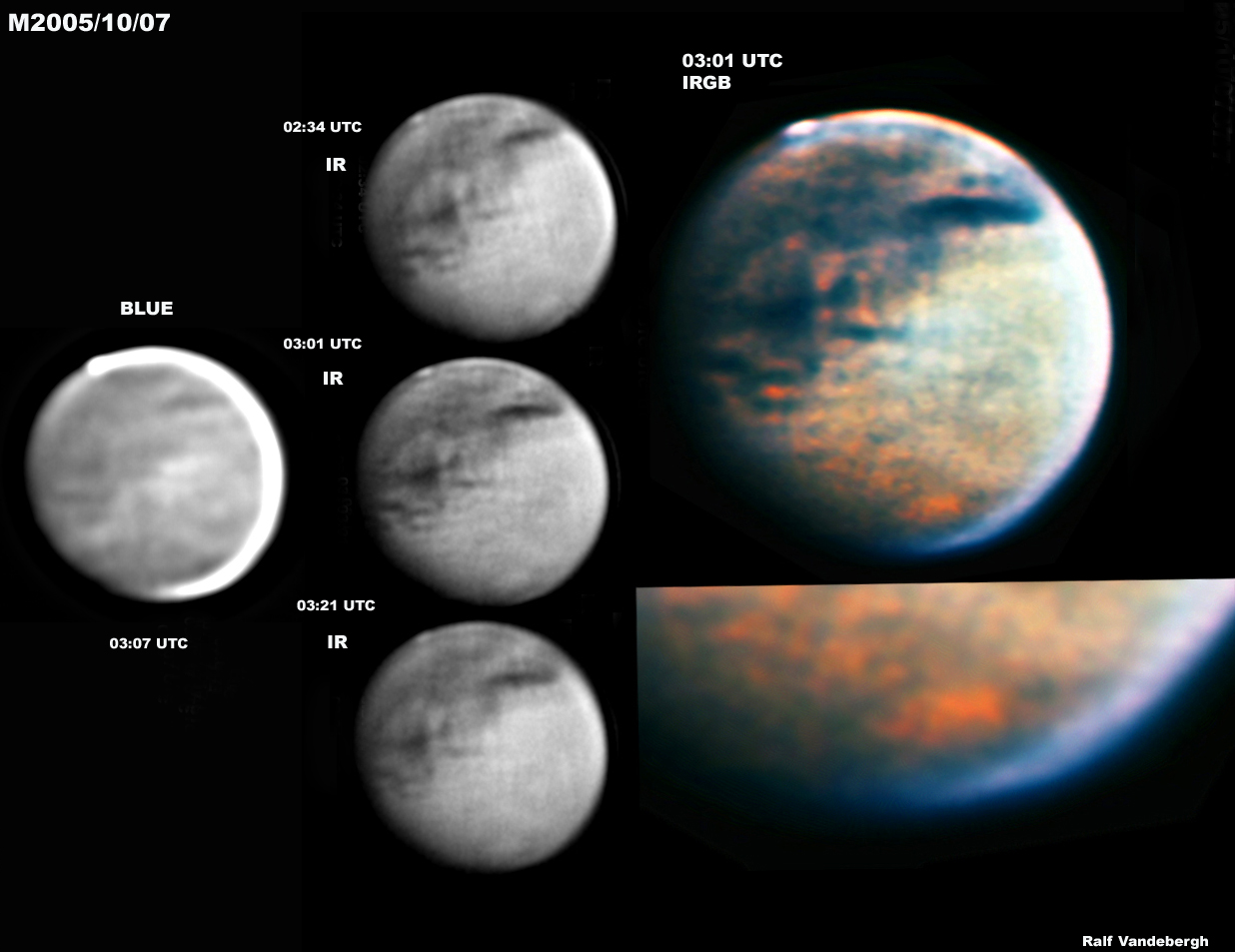 [バンディバ:オランダ]
[Ralf Vandebergh:Neighbourhood of Maastricht Netherlands]
[バンディバ:オランダ]
[Ralf Vandebergh:Neighbourhood of Maastricht Netherlands]
|
Lorenzo Comolli(Newton 310mm:Philips VestaPro BW)
|
Mars 7 November 2005 - 22.55 UT (red)
Telescope: Newton 310mm f/5 + bar TV 3x = Feq 7950mm (f/27)
Camera: Philips VestaPro BW
R: W25 hi-pass filter
B: W38a+IRcut
Elaboration: mean of 600/900 frame,unsharp mask
Notes: RGB obtained with G as mean of R and B exposures
RGB time is referred to R image,140% resample
Location: Tradate (VA,Italy) at 305 m
45°42’44.4”N,8°54’25.9”E
Seeing: II/III Antoniadi
Author: Lorenzo Comolli and Stefano Simonelli
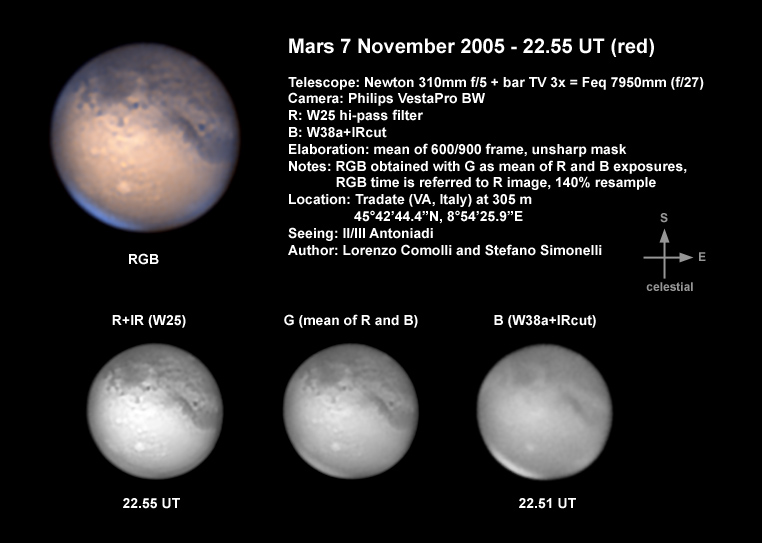 [Lorenzo Comolli:Tradate (VA,Italy)]
[Lorenzo Comolli:Tradate (VA,Italy)]
|
Geert Vandenbulcke(280mm SC(C-11);DMK 021BF04 Firewire Camera)
|
Mars on 7 Nov 2005. Seeing 5/10,Transparency 4/5.
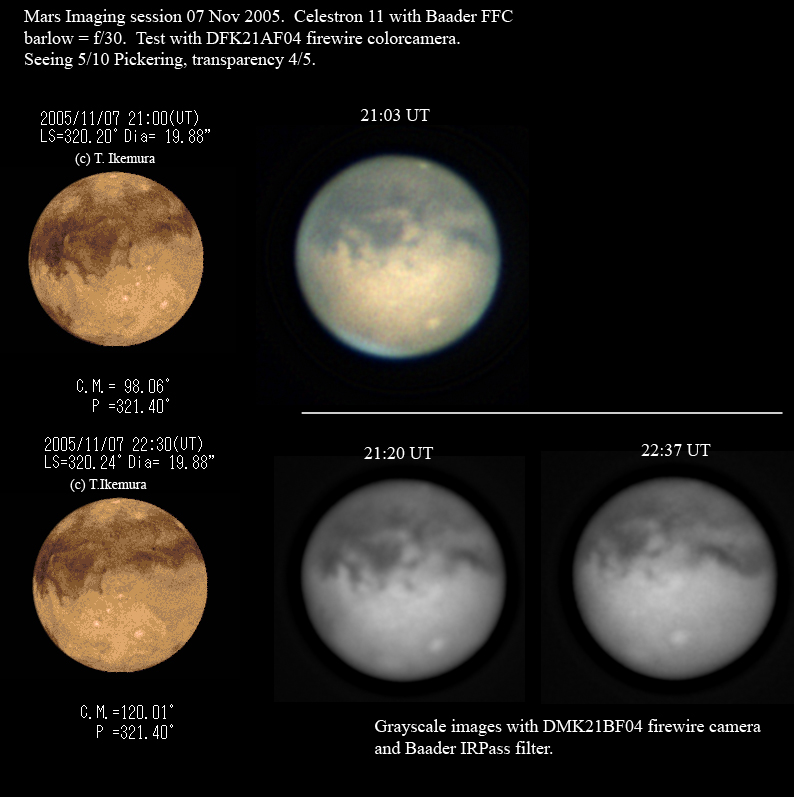 [ Geert Vandenbulcke:Koksijde,Belgium]
[ Geert Vandenbulcke:Koksijde,Belgium]
|
Hubble Space Telescope(2900mm fl=5300mm)
|
South up image
2005/11/07 04:27-04:33(UT)

Original 49kB jpg
対衝から4時間以内で対日点から0.31゜、対日現象を確認するために撮影されたそうです。
With apologies for the delay,attached is an RGB composite of our HST WFPC2 images of Mars from November 7. A TIFF and JPEG are attached,and an annotated JPEG is also attached that provides some more information on features of interest.
The images that went into the composite were obtained through the F410M,F502N,and F631N filters from 04:27 to 04:33 UT on 2005-11-07,within about four hours of the lowest phase (difference between Sun-Mars angle and Earth-Mars angle) that Mars has had during the lifetime of HST (around 0.31 degrees--effectively zero because that's about the same angle that the Sun subtends from Mars). This is the most "Full Mars" anyone can ever see from Earth,and we're still trying to figure out if we saw the so-called "opposition effect" brightening in these images. It's hard to tell because HST only observed Mars twice this opposition,on Oct. 28 (phase angle around 9 degrees),and Nov. 7,and opposite sides of the planet were viewed. We have to compare these images to ones from the past decade of HST Mars images to figure it out... In our spare time...
The "divot" taken out of the right side of the planet near the equator is real,and might be related to the high volcano Arsia Mons being almost exactly on the limb and for whatever reason (weather,probably) having fewer clouds than the surrounding plains at this particular time. Interesting geometric/meteorologic effect. The smallest features resolvable in the image (small craters and wind streaks) are about 35 km across.
I would have sent this out sooner,but I've been swamped. I could try to make up some far-fetched story about being busy driving rovers on Mars,but no one would believe me. Actually,another interesting note on these images is that we timed imaging and spectroscopic observations of the atmosphere and the surface of Mars from the Spirit rover to coincide exactly with the time that these HST images were acquired. It was about 2:00 p.m. on a sunny afternoon in Gusev crater... You can't *quite* resolve the rover in these images,but it's there...
This image should appear on the STScI "Hubble Heritage" web site soon,I hope (http://heritage.stsci.edu/2005/34/index.html). Dave Klassen: Could you please post these on your Marswatch 2005 site? Thanks... We owe a real debt of gratitude to the Hubble Heritage team for helping to collect these and the October 28 HST images. Without that program,there would have been no imaging of Mars by HST at all this year.
I have really been enjoying seeing all of your spectacular telescopic images of Mars this apparition. I'm glad I could contribute in a small way. Keep up the great work!
(by Jim Bell)
[NASA/JPL/Space Science Institute]
|
Ichirou Tasaka(730mm Cassegrain(530mm)) |
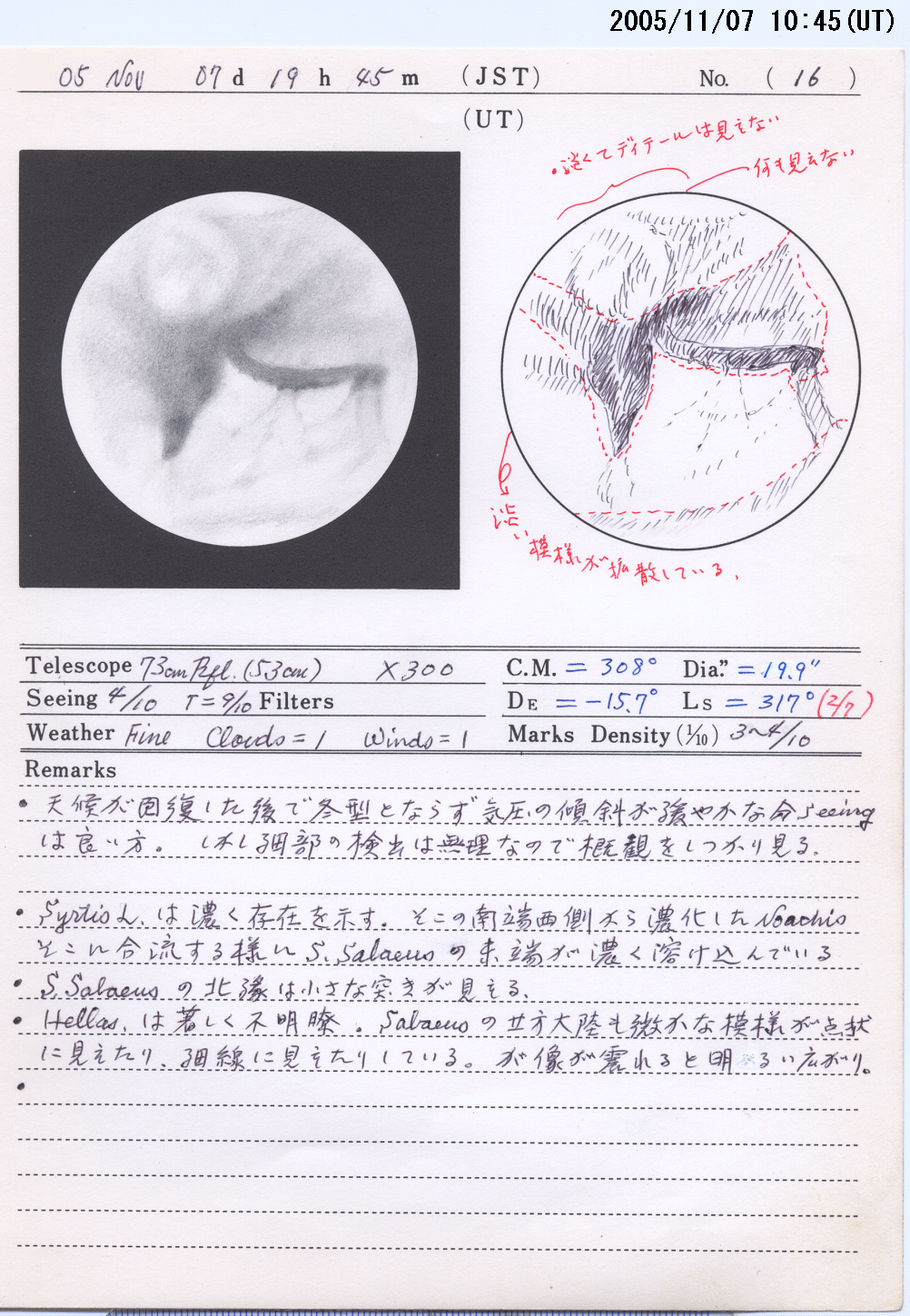
≪和歌山県新宮市 田阪一郎≫

 ≪神奈川県横浜市 米山誠一≫
≪神奈川県横浜市 米山誠一≫ ≪神奈川県 横浜市 三品利郎≫
≪神奈川県 横浜市 三品利郎≫ ≪京都府久世郡 風本明≫
≪京都府久世郡 風本明≫ [Masaru Arai Yorii-machi Saitama-Prefecture Japan]
≪埼玉県寄居町 新井 優≫
[Masaru Arai Yorii-machi Saitama-Prefecture Japan]
≪埼玉県寄居町 新井 優≫ [Hideo Einaga Kasai-City Hyogo-Prefecture Japan]
≪兵庫県 加西 永長英夫≫
[Hideo Einaga Kasai-City Hyogo-Prefecture Japan]
≪兵庫県 加西 永長英夫≫

 [Ayauta-gun Kagawa-Prefecture Japan]
≪香川県 綾歌郡 瀧本郁夫≫
[Ayauta-gun Kagawa-Prefecture Japan]
≪香川県 綾歌郡 瀧本郁夫≫ ≪大阪府堺市 熊森照明≫
≪大阪府堺市 熊森照明≫
 ≪京都府京都市 林敏夫≫
≪京都府京都市 林敏夫≫







 Mars fifteen hours after opposition. Note the bright central area of the disk that gives a three dimentional impression.
Also,the Olympus Mons are very prominent.
Mars fifteen hours after opposition. Note the bright central area of the disk that gives a three dimentional impression.
Also,the Olympus Mons are very prominent. [James Jefferson: United Kingdom]
[James Jefferson: United Kingdom]

 [Robert Heffner:Aichi,Japan]
[Robert Heffner:Aichi,Japan] [バンディバ:オランダ]
[Ralf Vandebergh:Neighbourhood of Maastricht Netherlands]
[バンディバ:オランダ]
[Ralf Vandebergh:Neighbourhood of Maastricht Netherlands] [Lorenzo Comolli:Tradate (VA,Italy)]
[Lorenzo Comolli:Tradate (VA,Italy)] [ Geert Vandenbulcke:Koksijde,Belgium]
[ Geert Vandenbulcke:Koksijde,Belgium]

 ALPO-Japan Latest
ALPO-Japan Latest